|
|
|
Sort Order |
|
|
|
Items / Page
|
|
|
|
|
|
|
| Srl | Item |
| 1 |
ID:
125643
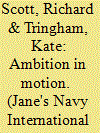

|
|
|
|
|
| Publication |
2013.
|
| Summary/Abstract |
The rebuilding of the Turkish naval forces command's specialist amphibious shipping capability is running hand in hand with efforts to develop the indigenous maritime industrial base.
|
|
|
|
|
|
|
|
|
|
|
|
|
|
|
|
| 2 |
ID:
128719
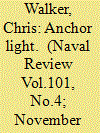

|
|
|
|
|
| Publication |
2013.
|
| Summary/Abstract |
Buster hated anchoring. In all his years in command of frigates no other ship's evolution had developed such capacity for cock - up. As he mounted the bridge ladder he expected the worst, and was rarely disappointed. An unconvincing report, the hint of a fumble on the focsle chippy's grubby cap at an unusually rakish angle - and the bridge steps would run red.
|
|
|
|
|
|
|
|
|
|
|
|
|
|
|
|
| 3 |
ID:
128738
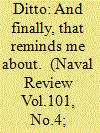

|
|
|
|
|
| Publication |
2013.
|
| Summary/Abstract |
Since I now live in the Gulf, it was a happy coincidence that found me in Portsmouth on 16th July 2013 and therefore able to attend the Centenary Party; and what a splendid affairs it was. I must have taken much work to prepare and I'm sure members will join me in thanking everyone involved.
|
|
|
|
|
|
|
|
|
|
|
|
|
|
|
|
| 4 |
ID:
131723
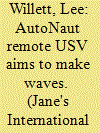

|
|
|
|
|
| Publication |
2014.
|
| Summary/Abstract |
UK based most autonomous vessels (AV) has demonstrated AutoNaut, it new wave-powered unmanned surface vessels (USV), developed as a long - endurance, low signature, autonomous monitoring and surveillance platform.
|
|
|
|
|
|
|
|
|
|
|
|
|
|
|
|
| 5 |
ID:
133482
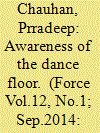

|
|
|
|
|
| Publication |
2014.
|
| Summary/Abstract |
As the world entered the last couple of decades of the 20th century, the sharply differing views and reactions of India and the United States (US) to unfolding global and regional events had brought bilateral relations to almost the nadir of the Nixon years. As James Heitzman and Robert L. Worden, the Washington-based editors of India: A Country Study have recorded (http://www.countrystudies.us/india/134.htm), "In the 1980s the Indian and United States governments had divergent views on a wide range of international issues, including Afghanistan, Cambodia, the Middle East, and Central America. Serious differences also remained over the US policy toward Pakistan and the issue of nuclear proliferation. India was repeatedly incensed in the Eighties when the US provided advanced military technology and other assistance to Pakistan despite the US' concerns about Pakistan's covert nuclear programme. For its part, Washington continued to urge New Delhi to sign the Treaty on the Non-Proliferation of Nuclear Weapons and, after the successful test launch of the Indian Agni intermediate-range ballistic missile in May 1989, called on New Delhi to refrain from developing a ballistic missile capability by adhering to the restrictions of the Missile Technology Control Regime". This unhappy prelude makes the vibrancy of the India-US bilateral defence relationship in general (and the maritime relationship in particular) over the very next decade all the more striking.
|
|
|
|
|
|
|
|
|
|
|
|
|
|
|
|
| 6 |
ID:
130602
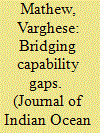

|
|
|
|
|
| Publication |
2014.
|
| Summary/Abstract |
Whoever controls the Indian Ocean, dominates Asia. This Ocean is the key to seven seas. In the 215'' century, the fate of the world would be decided on its waters".
Admiral Alfred Thayer Mahan
Indian Ocean is the third largest of the world's oceanic divisions. ; The world's earliest civilisations in Mesopotamia, ancient Egypt, the ' Indian subcontinent, Persia and later in Southeast Asia, all developed around the Indian Ocean. Today its littorals and hinterland comprises more than fifty nation states and two-thirds of the world's known reserves of strategic raw materials while an estimated 40 °/o of the world's offshore oil production comes from it.2 The Oceans have been historically the arenas for contest between maritime powers.
|
|
|
|
|
|
|
|
|
|
|
|
|
|
|
|
| 7 |
ID:
132856
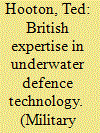

|
|
|
|
|
| Publication |
2014.
|
| Summary/Abstract |
While the UK's mercantile fleet is but an echo of its former glory with some 300 vessels over 500grt directly under the red ensign, the country continues to control substantial mercantile fleets. UK shipping has risen substantially to contribute £12.9 billion annually while services such as insurance, ship brokering and legal work provide some £3.8 billion, indeed directly and indirectly shipping provided the UK economy with some £56 billion) annual turnover.
|
|
|
|
|
|
|
|
|
|
|
|
|
|
|
|
| 8 |
ID:
131972
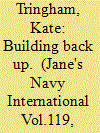

|
|
|
|
|
| Publication |
2014.
|
| Summary/Abstract |
Canada has embarked on an ambitious fleet replacement plan which will at the same time re-establish a sovereign industrial base for the design and support of naval and constabulary ships, Kate Tringham assesses progress to data
|
|
|
|
|
|
|
|
|
|
|
|
|
|
|
|
| 9 |
ID:
129350


|
|
|
|
|
| Publication |
2012.
|
| Summary/Abstract |
to shore up its depleting naval fleet, India is expected this year to issue an $11 bn global tender for building six next generation conventional submarine. In this future RFP called project -75 India, five international vendors are likely to bid.
|
|
|
|
|
|
|
|
|
|
|
|
|
|
|
|
| 10 |
ID:
128720
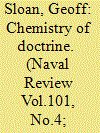

|
|
|
|
|
| Publication |
2013.
|
| Summary/Abstract |
In this the concluding part of his series on the chemistry of doctrine, the author examines the further evolution of naval doctrine during the second world war, with specific reference to the battle of Atlantic . He concludes by surveying the whole three part series and drawing some enduring lessons and principles.
|
|
|
|
|
|
|
|
|
|
|
|
|
|
|
|
| 11 |
ID:
128659
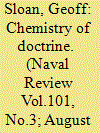

|
|
|
|
|
| Publication |
2013.
|
| Summary/Abstract |
In the second part of his series of articles, the author examines the development of naval doctrine through the 18th century, culminating in the production and publication of the fighting doctrine which informed the first world war, and governed the conduct of the battle of Jutland in 1916
|
|
|
|
|
|
|
|
|
|
|
|
|
|
|
|
| 12 |
ID:
128638
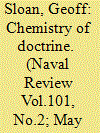

|
|
|
|
|
| Publication |
2013.
|
| Summary/Abstract |
The author, in a three part series examines the evolution of naval warfighting doctrine, with examples, and seeks to set out a grammar of doctrine.
Within the context of the present highly complex and shifting environment and in the face rapid technological change, it is not unreasonable to question the validity of doctrine - Albert Palazzo -2008
Knowing the enemy is the bedrock of the business of strategy: strategic theories in comparison, are second order problems. To concentrate on doctrine before enemies is to put the theoretical cart before the actual horse -a double error - Ken Booth, 1979
Doctrine is the box outside of which we need to think- Colonel Rory Copinger, Symes, Royal Marine-2010
|
|
|
|
|
|
|
|
|
|
|
|
|
|
|
|
| 13 |
ID:
132883
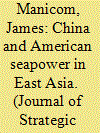

|
|
|
|
|
| Publication |
2014.
|
| Summary/Abstract |
Debates about the future of American seapower in East Asia turn on the argument that American seapower presents a risky and costly luxury that undercuts the cooperative potential of US-China relations. This article asks whether accommodation between China and the United States on the possession and exercise of American seapower in East Asia is possible. Accommodation on this front could significantly lower the risks of unintended escalation and in turn undermine arguments that favour an American retreat from East Asia. The article outlines how accommodation can be achieved on the exercise of American seapower in the region.
|
|
|
|
|
|
|
|
|
|
|
|
|
|
|
|
| 14 |
ID:
131191
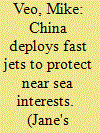

|
|
|
|
|
| Publication |
2014.
|
| Summary/Abstract |
Recent events in the South China and East China seas suggest an increase in the confidence and capabilities of the china's People's Liberation Army Air Force (PLAAF) and People's Liberation Army Navy Air Force (PLANAF).
|
|
|
|
|
|
|
|
|
|
|
|
|
|
|
|
| 15 |
ID:
132787


|
|
|
|
|
| Publication |
2014.
|
| Summary/Abstract |
China will soon have its first credible sea-based nuclear deterrent, according to a U.S. Defense Department report released last month.
The report said Beijing is placing a "high priority" on updating and developing its submarine force and will soon deploy the Julang-2 (JL-2) submarine-launched ballistic missile (SLBM) on its Jin-class submarine.
The Defense Department is required by law to submit an annual report to Congress on China's military capabilities and force modernization.
|
|
|
|
|
|
|
|
|
|
|
|
|
|
|
|
| 16 |
ID:
130755


|
|
|
|
|
| Publication |
2014.
|
| Summary/Abstract |
Despite price-tag increases, the new Ford -class carriers won't be a boondoggle, but a boon-because ultimately, bigger = more bang for the buck.
On 9 November 2013 the nation's newest aircraft carrier, the Gerald R. Ford , was christened and blessed at a time-honored ceremony in which the hull is first wetted by the special liquid of a bottle-now champagne-to give her good luck before launching her into the water. The Ford has been built at great expense, now estimated to be $12.9 billion inclusive of design costs. Some are surprised at the price tag and argue that it is unaffordable, and that the U.S. Navy and the shipbuilder must dramatically reduce this dollar amount if we are to continue to buy and build these ships. Now that we have christened the Ford and can see her, it is a good time to review why we built her, why three administrations-two Democrat (Clinton/Obama) and one Republican (Bush-43)-as well as seven Congresses (106th-112th) have initially approved not only the Gerald R. Ford (CVN-78), but also the John F. Kennedy (CVN-79), and the Enterprise (CVN-80).
|
|
|
|
|
|
|
|
|
|
|
|
|
|
|
|
| 17 |
ID:
129855
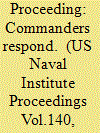

|
|
|
|
|
| Publication |
2014.
|
| Summary/Abstract |
In today's complex and dynamic threat environment, military leaders must effectively employ limited resources to execute their country's national security strategy. Proceedings asked sea service commanders around the world; it is often said that a nation's national defecne decisions are ultimately derived from its own sovereign interests. Given this presumption, what are the global trends that most influence your national security decision making and how does your navy use its operating policies, alliance and partnership to address these trends.
|
|
|
|
|
|
|
|
|
|
|
|
|
|
|
|
| 18 |
ID:
133068
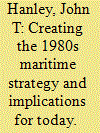

|
|
|
|
|
| Publication |
2014.
|
| Summary/Abstract |
While important differences exist, the first decade of the twenty-first century paralleled the 1970s for the Department of Defense and the U.S. Navy. U.S. armed forces were embroiled in extended and expensive counterinsurgency wars. American military equipment was growing old, budgets were tight, and extended projections called for significant decreases in the nation's armed forces, just as the main prospective military adversary was both rapidly modernizing and expanding its forces, particularly its navy. "From 1962 to 1972, the navy had programmed the construction of 42 ships per year, but between 1968 and 1975 only 12 ships, or less than a third as many per year, were programmed. In 1975, given the age of ships already at sea, and the navy-expected service life for a warship of 25-30 years, the service anticipated retiring about 4 percent of the active fleet each year."1 The Soviets were extending their defensive perimeter from two to three thousand kilometers.2 Today, the Chinese suggest extending their defensive perimeter from the "first island chain," enclosing the East and South China Seas, to the second, bounded by the Marianas, three thousand kilometers from the Chinese coast.3 In the 1970s, the United States questioned its own ability to fight forward, defend allies, and achieve objectives -as many defense analysts and many in the Navy do now.
|
|
|
|
|
|
|
|
|
|
|
|
|
|
|
|
| 19 |
ID:
133071
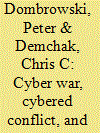

|
|
|
|
|
| Publication |
2014.
|
| Summary/Abstract |
It has been well over a decade since the first “prophets” of information warfare proclaimed a new age of conflict fought not just on air, sea, and land but with electrons in what came to be known as “cyberspace.”1 Since these early predictions, many incidents have confirmed that criminals, random hackers, and government-sanctioned specialists can wreak havoc on governments, military communications systems, and corporations. The Stuxnet worm alone helped delay-by months, perhaps years-the long-standing efforts of Iran to acquire sufficient nuclear material to build nuclear weapons.2 Recent revelations of hacking campaigns against such publications as the Wall Street Journal and New York Times have broadened concerns to include even the integrity of American democratic institutions.3 Meanwhile, the commander of U.S. Cyber Command has characterized cyber attacks designed to gain access to the intellectual property of American corporations as the “greatest transfer of wealth in human history.”
|
|
|
|
|
|
|
|
|
|
|
|
|
|
|
|
| 20 |
ID:
133454
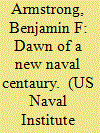

|
|
|
|
|
| Publication |
2014.
|
| Summary/Abstract |
Realizing an important strategic goal, the U.S. Naval Institute has just completed digitizing every issue of Proceedings published over 140 years. With the contents preserved electronically, they will be available to Members now and in the years to come to access, use, and enjoy.
A s the 20th century dawned, the United States of America stepped into a new position on the world stage. The Indian Wars had end ed in the previous decade. Manifest Destiny was complete.
|
|
|
|
|
|
|
|
|
|
|
|
|
|
|
|
|
|
|
|
|